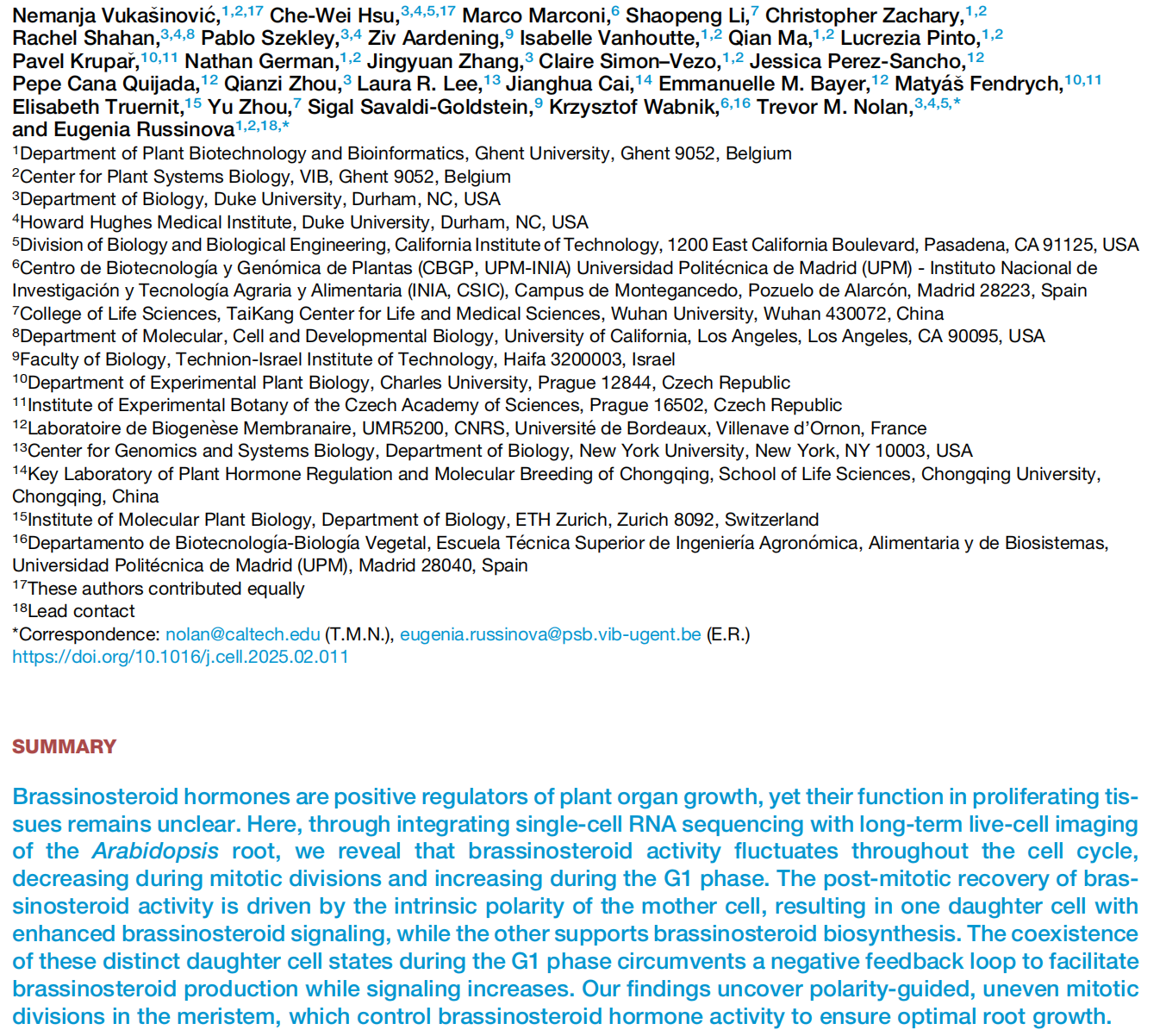
伤口世界
- 星期五, 04 7月 2025
Motor and vestibular signals in the visual cortex permit the separation of self versus externally generated visual motion
Mateo Ve´ lez-Fort,1,3 Lee Cossell,1,3 Laura Porta,1 Claudia Clopath,1,2 and Troy W. Margrie1,4,*
1 Sainsbury Wellcome Centre, University College London, London, UK
2 Bioengineering Department, Imperial College London, London, UK
3 These authors contributed equally
4 Lead contact
*Correspondence: 该Email地址已收到反垃圾邮件插件保护。要显示它您需要在浏览器中启用JavaScript。
https://doi.org/10.1016/j.cell.2025.01.032
SUMMARY
Knowing whether we are moving or something in the world is moving around us is possibly the most critical sensory discrimination we need to perform. How the brain and, in particular, the visual system solves this motion-source separation problem is not known. Here, we find that motor, vestibular, and visual motion signals are used by the mouse primary visual cortex (VISp) to differentially represent the same visual flow information according to whether the head is stationary or experiencing passive versus active translation. During locomotion, we find that running suppresses running-congruent translation input and that translation signals dominate VISp activity when running and translation speed become incongruent. This cross-modal interaction between the motor and vestibular systems was found throughout the cortex, indicating that running and translation signals provide a brain-wide egocentric reference frame for computing the internally generated and actual speed of self when moving through and sensing the external world.

- 星期四, 03 7月 2025
Mapping the landscape of social behavior
Ugne Klibaite,1,4,* Tianqing Li,2,4 Diego Aldarondo,1,3 Jumana F. Akoad,1 Bence P. O¨ lveczky,1,* and Timothy W. Dunn2,5,*
1 Department of Organismic and Evolutionary Biology, Harvard University, Cambridge, MA 02138, USA
2 Department of Biomedical Engineering, Duke University, Durham, NC 27708, USA
3 Present address: Fauna Robotics, New York, NY 10003, USA
4 These authors contributed equally
5 Lead contact
*Correspondence: 该Email地址已收到反垃圾邮件插件保护。要显示它您需要在浏览器中启用JavaScript。 (U.K.), 该Email地址已收到反垃圾邮件插件保护。要显示它您需要在浏览器中启用JavaScript。 (B.P.O¨ .), 该Email地址已收到反垃圾邮件插件保护。要显示它您需要在浏览器中启用JavaScript。 (T.W.D.)
https://doi.org/10.1016/j.cell.2025.01.044
SUMMARY
Social interaction is integral to animal behavior. However, lacking tools to describe it in quantitative and rigorous ways has limited our understanding of its structure, underlying principles, and the neuropsychiatric disorders, like autism, that perturb it. Here, we present a technique for high-resolution 3D tracking of postural dynamics and social touch in freely interacting animals, solving the challenging subject occlusion and partassignment problems using 3D geometric reasoning, graph neural networks, and semi-supervised learning. We collected over 110 million 3D pose samples in interacting rats and mice, including seven monogenic autism rat lines. Using a multi-scale embedding approach, we identified a rich landscape of stereotyped actions, interactions, synchrony, and body contacts. This high-resolution phenotyping revealed a spectrum of changes in autism models and in response to amphetamine not resolved by conventional measurements. Our framework and large library of interactions will facilitate studies of social behaviors and their neurobiological underpinnings.

- 星期四, 26 6月 2025
Large language models deconstruct the clinical intuition behind diagnosing autism
Jack Stanley,1,2,6 Emmett Rabot,3,4,6 Siva Reddy,1 Eugene Belilovsky,1,5 Laurent Mottron,3,4,7 and Danilo Bzdok1,2,7,8,*
1 Mila - Que´ bec Artificial Intelligence Institute, Montre´ al, QC H2S3H1, Canada
2 The Neuro - Montre´ al Neurological Institute (MNI), McConnell Brain Imaging Centre, Department of Biomedical Engineering, Faculty of Medicine, School of Computer Science, McGill University, Montre´ al, QC H3A2B4, Canada
3 Research Center, Centre Inte´ gre´ Universitaire de Sante´ et de Services Sociaux du Nord-de-lIle-de-Montre´ al (CIUSSS-NIM), Montre´ al, QC H4K1B3, Canada
4 Universite´ de Montre´ al, Montre´ al, QC H3C3J7, Canada
5 Department of Computer Science and Software Engineering, Concordia University, Montreal, QC H3G 1M8, Canada
6 These authors contributed equally
7 These authors contributed equally
8 Lead contact
*Correspondence: 该Email地址已收到反垃圾邮件插件保护。要显示它您需要在浏览器中启用JavaScript。
https://doi.org/10.1016/j.cell.2025.02.025
SUMMARY
Efforts to use genome-wide assays or brain scans to diagnose autism have seen diminishing returns. Yet the clinical intuition of healthcare professionals, based on longstanding first-hand experience, remains the gold standard for diagnosis of autism. We leveraged deep learning to deconstruct and interrogate the logic of expert clinician intuition from clinical reports to inform our understanding of autism. After pre-training on hundreds of millions of general sentences, we finessed large language models (LLMs) on >4,000 free-form health records from healthcare professionals to distinguish confirmed versus suspected autism cases. By introducing an explainability strategy, our extended language model architecture could pin down the most salient single sentences in what drives clinical thinking toward correct diagnoses. Our framework flagged the most autism-critical DSM-5 criteria to be stereotyped repetitive behaviors, special interests, and perception-based behaviors, which challenges today,s focus on deficits in social interplay, suggesting necessary revision of long-trusted diagnostic criteria in gold-standard instruments.

- 星期二, 24 6月 2025
Jumbo phage killer immune system targets early infection of nucleus-forming phages
Li Yuping,1,7,* Linlin Guan,2 Isabelle Becher,3 Kira S. Makarova,4 Xueli Cao,2 Surabhi Hareendranath,1 Jingwen Guan,1 Frank Stein,3 Siqi Yang,2 Arne Boergel,3 Karine Lapouge,3 Kim Remans,3 David Agard,5 Mikhail Savitski,3 Athanasios Typas,3 Eugene V. Koonin,4 Yue Feng,2,* and Joseph Bondy-Denomy1,6,8,*
1 Department of Microbiology and Immunology, University of California, San Francisco, San Francisco, CA 94403, USA
2 State Key Laboratory of Green Biomanufacturing, College of Life Science and Technology, Beijing University of Chemical Technology, Beijing 100029, China
3 European Molecular Biology Laboratory (EMBL), Meyerhofstraße 1, 69117 Heidelberg, Germany
4 Computational Biology Branch, Division of Intramural Research, National Library of Medicine, National Institutes of Health, Bethesda, MD 20894, USA
5 The Chan-Zuckerberg Institute for Advanced Biological Imaging and the Department of Biochemistry, University of California, San Francisco, San Francisco, CA 94143, USA
6 Quantitative Biosciences Institute, University of California, San Francisco, San Francisco, CA 94403, USA
7 Present address: Biozentrum, University of Basel, Basel 4056, Switzerland
8 Lead contact
*Correspondence: 该Email地址已收到反垃圾邮件插件保护。要显示它您需要在浏览器中启用JavaScript。 (L.Y.), 该Email地址已收到反垃圾邮件插件保护。要显示它您需要在浏览器中启用JavaScript。 (Y.F.), 该Email地址已收到反垃圾邮件插件保护。要显示它您需要在浏览器中启用JavaScript。 (J.B.-D.)
https://doi.org/10.1016/j.cell.2025.02.016
SUMMARY
Jumbo bacteriophages of the fKZ-like family assemble a lipid-based early phage infection (EPI) vesicle and a proteinaceous nucleus-like structure during infection. These structures protect the phage from nucleases and may create selective pressure for immunity mechanisms targeting this specific phage family. Here, we identify ‘‘jumbo phage killer’’ (Juk), a two-component immune system that terminates infection of fKZ-like phages, suppressing the expression of early phage genes and preventing phage DNA replication and phage nucleus assembly while saving the cell. JukA (formerly YaaW) rapidly senses the EPI vesicle by binding to an early-expressed phage protein, gp241, and then directly recruits JukB. The JukB effector structurally resembles a pore-forming toxin and destabilizes the EPI vesicle. Functional anti-fKZ JukA homologs are found across bacterial phyla, associated with diverse effectors. These findings reveal a widespread defense system that specifically targets early events executed by fKZ-like jumbo phages prior to phage nucleus assembly.

- 星期一, 23 6月 2025
n-cell structure and snapshots of copia retrotransposons in intact tissue by cryo-ET
Sven Klumpe,1,9,* Kirsten A. Senti,2 Florian Beck,1 Jenny Sachweh,3 Bernhard Hampoelz,3 Paolo Ronchi,4 Viola Oorschot,4 Marlene Brandstetter,6 Assa Yeroslaviz,5 John A.G. Briggs,7 Julius Brennecke,2,* Martin Beck,3,8,* and Ju¨ rgen M. Plitzko1,*
1 Research Group CryoEM Technology, Max Planck Institute of Biochemistry, Martinsried, Germany
2 Institute of Molecular Biotechnology Austria (IMBA), Vienna, Austria
3 Department Molecular Sociology, Max Planck Institute of Biophysics, Frankfurt, Germany
4 EMBL EM Core Facility, European Molecular Biology Laboratory (EMBL), Heidelberg, Germany
5 Computational Systems Biochemistry, Bioinformatics Core Facility, Max Planck Institute of Biochemistry, Martinsried, Germany
6 Electron Microscopy Facility, Vienna BioCenter Core Facilities, Vienna, Austria
7 Department of Cell and Virus Structure, Max Planck Institute of Biochemistry, Martinsried, Germany
8 Institute of Biochemistry, Goethe University Frankfurt, Frankfurt, Germany
9 Lead contact
*Correspondence: 该Email地址已收到反垃圾邮件插件保护。要显示它您需要在浏览器中启用JavaScript。 (S.K.), 该Email地址已收到反垃圾邮件插件保护。要显示它您需要在浏览器中启用JavaScript。 (J.B.), 该Email地址已收到反垃圾邮件插件保护。要显示它您需要在浏览器中启用JavaScript。 (M.B.), 该Email地址已收到反垃圾邮件插件保护。要显示它您需要在浏览器中启用JavaScript。 (J.M.P.)
https://doi.org/10.1016/j.cell.2025.02.003
SUMMARY
Long terminal repeat (LTR) retrotransposons belong to the transposable elements (TEs), autonomously replicating genetic elements that integrate into the host,s genome. Among animals, Drosophila melanogaster serves as an important model organism for TE research and contains several LTR retrotransposons, including the Ty1-copia family, which is evolutionarily related to retroviruses and forms viruslike particles (VLPs). In this study, we use cryo-focused ion beam (FIB) milling and lift-out approaches to visualize copia VLPs in ovarian cells and intact egg chambers, resolving the in situ copia capsid structure to 7.7 A˚ resolution by cryoelectron tomography (cryo-ET). Although cytoplasmic copia VLPs vary in size, nuclear VLPs are homogeneous and form densely packed clusters, supporting a model in which nuclear import acts as a size selector. Analyzing flies deficient in the TE-suppressing PIWI-interacting RNA (piRNA) pathway, we observe copia,s translocation into the nucleus during spermatogenesis. Our findings provide insights into the replication cycle and cellular structural biology of an active LTR retrotransposon.


